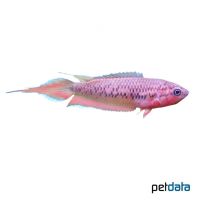Brown Spiketail Paradise (Pseudosphromenus dayi)
| Brown Spiketail Paradise Pseudosphromenus dayi | |
|---|---|
| Name | Brown Spiketail Paradise |
| Name Lat. | Pseudosphromenus dayi |
| Synonym | Macropodus dayi |
| Family | Gouramies |
| Family lat. | Osphronemidae |
| Order | Labyrinth Fishes |
| Order lat. | Anabantiformes |
| Origin | SW-India |
| Habitat | Streams, swamps, floodplains |
| Diet | Carnivore |
| pH | 6.0-7.5 |
| Behavior | Peaceful |
| Keeping | Pair |
| Care Level | Moderate |
| Reproduction | Cave spawner |
| Breeding | Moderately difficult |
| Life Span | 4-5 years |
| Protection | No |
| Metric Units | |
| Size | 7 cm |
| Temperature | 21-26 °C |
| Hardness | 2-15 °dH |
| Aquarium | ~ 150 l |
| US Units | |
| Size | 2.8" |
| Temperature | 70-79 °F |
| Hardness | 36-267 ppm |
| Aquarium | ~ 40 gal |
Distribution and habitat
The distribution area of the Red Sharp-tailed Macropods is exclusively (endemic) the Malabar Coast area in Kerala, southwest India. They live there in waters with dense vegetation, such as streams, ponds, ditches, swamps and floodplains.
Maintenance
The aquarium should have dense planting with many hiding places (roots, stones, caves). A dark substrate with foliage (sea almond leaves) and subdued light (floating plant cover) is ideal.
No ammonia, ammonium and nitrite should be detectable, the nitrate value should not exceed 100 mg/l. To ensure the water quality and oxygen content, a filter and heater adapted to the aquarium size is required, as well as lighting for the species-appropriate day-night rhythm of the animals.
Diet
In nature they feed mainly on insect larvae and plankton. The food supply consists of live, frozen and dry food. For a balanced diet, feed once a day with a high-quality dry food (flakes, granules, pellets) as well as cyclops, daphnia, artemia, tubifex, mosquito larvae, etc. (live or frozen)
It is recommended to feed small portions several times a day, which are eaten within a few minutes. A regular and varied diet promotes health and increases resistance.
Behaviour and compatibility
They are peaceful and shy fish that should be kept in pairs. A socialization with other small and peaceful fish is well possible, but better is the attitude in a species tank.
In principle, only mutually compatible fish species with similar requirements to the water condition and water temperature may be socialized.
Sex dimorphism
The differentiation of the sexes is difficult. The males are sts lighter, around the throat somewhat orange colored and have longer extended dorsal and anal fins
Reproduction and breeding
They build a loose foam nest in a cave (flowerpot, tube) and the male takes over the brood care. The eggs ejected during the numerous matings (entwinements) are collected by the male and female and placed in the nest. The larvae hatch after 24-36 hours and swim freely after 2-4 days.
The fry must be fed several times a day with special rearing food (dust food, Artemia nauplii). In a community tank breeding is hardly possible, because the spawn is easy prey.
Important
They have an additional respiratory organ, the so-called labyrinth (suprabranchial organ) with which they breathe atmospheric air and can suffocate if this is not possible. The air temperature in the breathing area must not be below the water temperature!
The well-being of the fish should be checked regularly. The temperature should be checked daily, the pH, hardness and nitrate value at least every 14 days. A regular partial water change is recommended, even if the pollutant load has not yet reached the upper limit. Sudden changes in water quality should be avoided. Newly introduced fish must be accustomed slowly to the water in the aquarium.
Further literature can be found in your pet store.
References
Text: petdata; Image: petdata
Source: BMEL (1998): Tierschutzgutachten - Haltung von Zierfischen (Süßwasser); RIEHL & BAENSCH (2006): Aquarien Atlas Bd. 1, Mergus Verlag; ENGELMANN (2006): Zootierhaltung - Tiere in menschlicher Obhut: Fische, Verlag Harri Deutsch
- Gemäß § 21 Abs. 5 Tierschutzgesetz idgF
